Room of the Segnatura
- The Museum
- Raphael's Rooms
- Room of the Segnatura
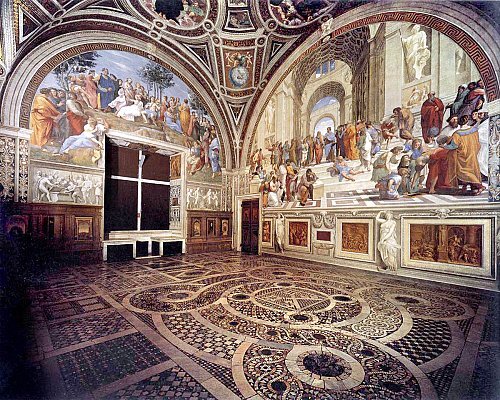 Room of the Segnatura
Room of the Segnatura
In the Segnatura, Raffaello began to paint what would become his most famous frescoes. Not only was this his first commission for the Vatican, but for many historians it marks the true beginning of High Renaissance art. The room takes its name from the Supreme Court of the Holy See - the Segnatura Gratiae et Iustitiae - over which the Pope himself presided and which, until the mid-16th century, held its sessions here. It was first used as a library and private study by Julius II (who was pope from 1503 to 1513), an intention that is well expressed or reflected in the iconographic programme of the frescoes painted between 1508 and 1511.
In fact, this programme was certainly drawn up by a theologian to describe three ultimate categories in which the human spirit operates: True, Good, Beautiful. Disputa illustrates supernatural truth (theology), while the School of Athens represents rational truth (philosophy). Goodness through the cardinal and theological virtues with the Law; Beauty through 'Parnassus', with Apollo and the Muses. The ceiling frescoes have much to do with what goes on below. Allegories of Theology, Philosophy, Justice, and Poetry, were intended as a rather direct indication of the faculties of the mind on these various walls.
In the time of Leo X (1513-1521) it was only a small study and music room, which also housed the Pope's collection of musical instruments; all the original furniture from the time of Julius II was removed and replaced by new wooden panelling by Fra Giovanni da Verona, which covered all the walls except for that of Parnassus, since there was no room for it; it had to be frescoed here, which is still visible. After the Sack of Rome, the wooden paneling probably disappeared in 1527 and was replaced by a chiaroscuro paneling painted by Perin del Vaga during the pontificate of Paul III, between the years 1534 and 1549.
School of Athens
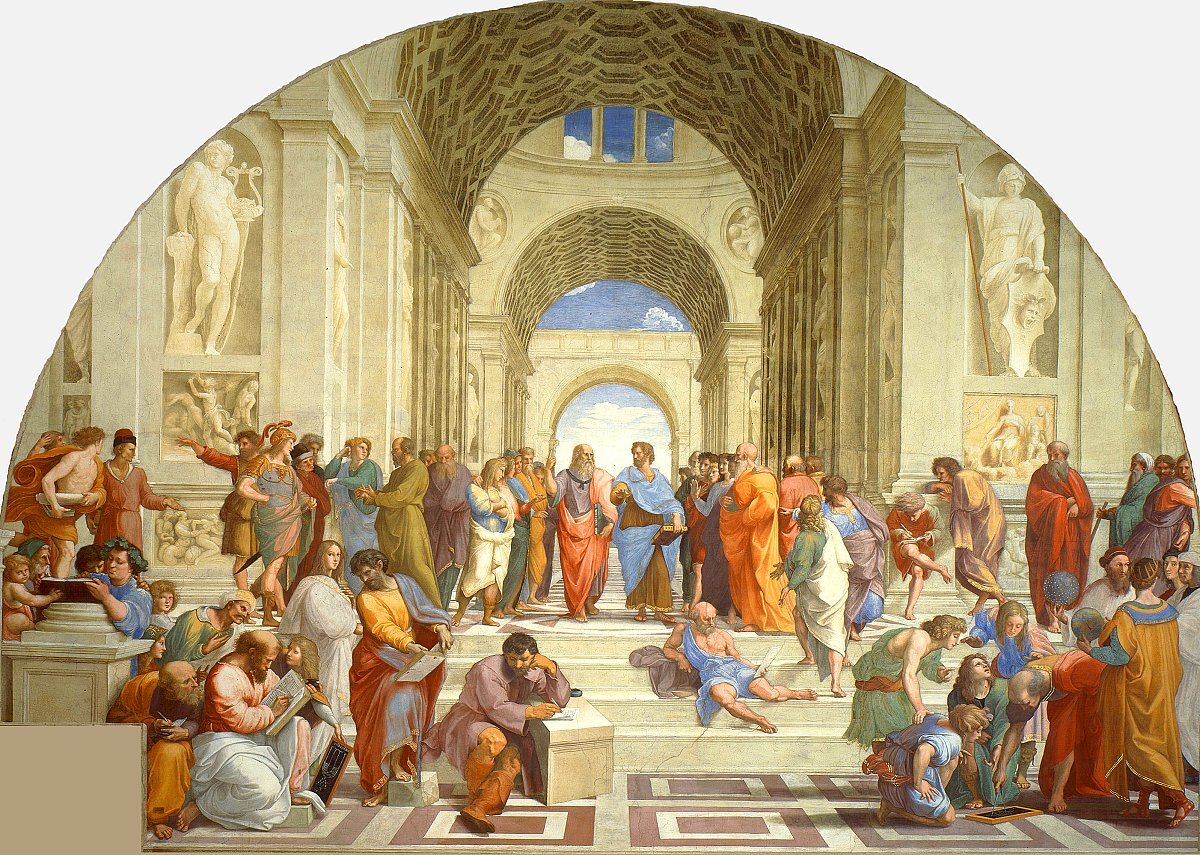
The most famous philosophers of antiquity move within an imposing Renaissance architecture inspired by Bramante's project for the renewal of the early Christian Basilica of St Peter.
Some of them are easily recognisable. In the centre, Plato, pointing upwards with one finger and holding his book Timeus, is flanked by Aristotle with the Ethics; in the foreground, Pythagoras is shown explaining the Diatesseron. Diogenes lies on the stairs with a bowl, while the pessimistic philosopher Heraclitus, a portrait by Michelangelo, leans against a block of marble and writes on a sheet of paper. Michelangelo was at this time working on the paintings in the nearby Sistine Chapel.
On the right we see Euclid teaching geometry to his pupils, Zoroaster holding the celestial sphere and Ptolemy the earthly sphere. The figure on the far right, wearing a black beret, is a self-portrait of Raphael.
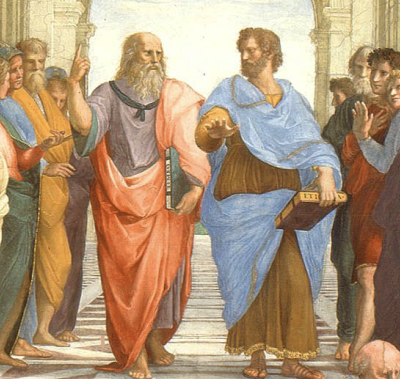
Plato and Aristotle
The School of Athens is dedicated to the ancient Greek school of philosophy.
In the centre, the silhouettes of the two great philosophers stand out, Plato with his book entitled Timaeus and Aristotle with his Ethics.
Their extremely simple gestures admirably summarise the different approaches of the two greatest systems of thought of the time, idealism and realism.
The former points to the sky as the source of knowledge, the latter to the earth.
Surprisingly, any reference to modern philosophers of the Church has been banned from the scene.
Other characters
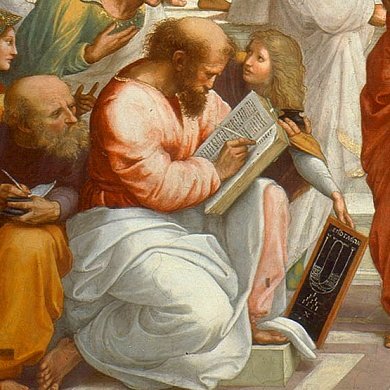
Among the other recognisable philosophers, in the foreground on the left is Pythagoras, seated with a book resting on his bent leg.
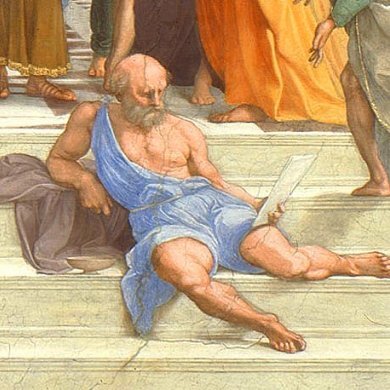
The old man sitting awkwardly on the steps is the cynical Diogenes, with the bowl at his side, the only possession he traditionally had.
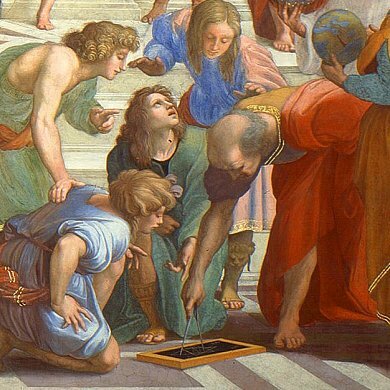
Mirroring Pythagoras, on the right, Euclid is demonstrating something to his students, using a compass.
A Tribute to Michelangelo
The pensive figure in the foreground, sitting near a block of marble, was added by Raphael to the finished work.
Some believe it to be a portrait of Michelangelo.
More likely, it is a tribute to the amazing frescoes in the Sistine Chapel that had just been discovered. The pose of the figure recalls that of Michelangelo's sibyls and prophets, particularly Isaiah.
.
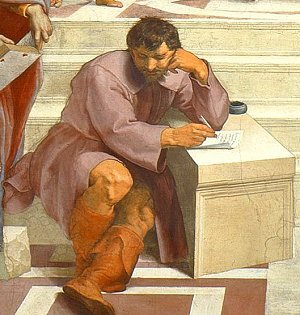
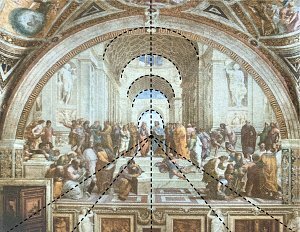
The Perspective
The scene is set inside a grandiose building, with colossal statues reminiscent of the ancient world.
The succession of arches guides the viewer's gaze, like a sort of perspective telescope, to the two main figures of Plato and Aristotle.
Parnassus
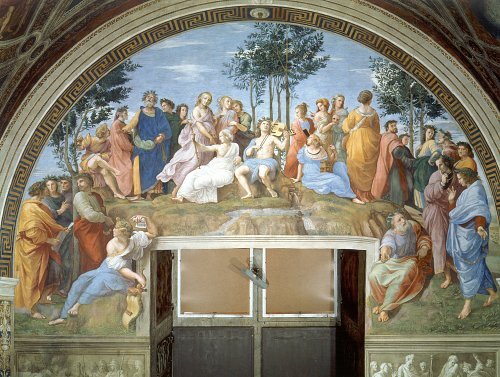
The Parnassus is one of the frescoes decorating the interior of the Stanza della Segnatura, the first of the rooms frescoed by Raphael at the behest of Julius II.
It housed the Pope's private library, which at his death contained only 220 volumes. Julius II was a man of action rather than words. When Michelangelo asked him what attribute he wanted to be depicted with in the statue he was creating for Bologna, the Pope replied that he wanted to hold a sword rather than a book. While Raphael was working on the Stanza della Segnatura, Julius II was leading the papal army on victorious military campaigns in northern Italy.
However, the pope wanted the library to be the first room to be decorated by Raphael. A visit to the Stanza della Segnatura may cast some doubt on the room's original purpose, as the walls, entirely covered with paintings, are far from our idea of a library with shelves reaching to the ceiling.
The iconographic programme of the Stanza della Segnatura, in keeping with the function of the room, is rich in references to humanistic culture. On the ceiling, in precious frames, are four women: they are the personifications of Theology, Poetry, Philosophy and Jurisprudence.
Below, a multitude of figures, protagonists of a more or less recent past, illustrate these four disciplines with greater concreteness and detail: theology corresponds to the Disputation of the Sacrament, a reference to the sacredness of the Eucharistic mystery; philosophy to the School of Athens; jurisprudence to allegories of the cardinal and theological virtues and scenes relating to natural and ecclesiastical law; and finally, poetry to Parnassus.
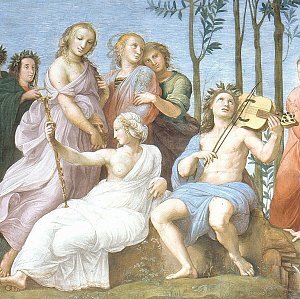
The scene depicts Mount Parnassus, considered the paradise of poets.
In the centre is Apollo, god of music and poetry, surrounded by the Muses, goddesses who inspire intellectual activity. Some of them hold objects that help to identify them:
- Melpomene, dressed in purple, with a tragic theatre mask;
- Calliope, patroness of epic poetry, with a trumpet;
- Clio, the muse of historical narration, with a book;
- Terpsichore, the muse of dance, with a stringed instrument;
- Thalia with a comic theatre mask.
In other cases, the identification is uncertain, perhaps because Raphael himself was not interested in their precise characterisation
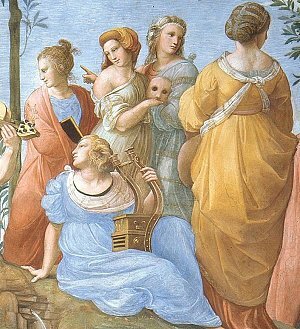
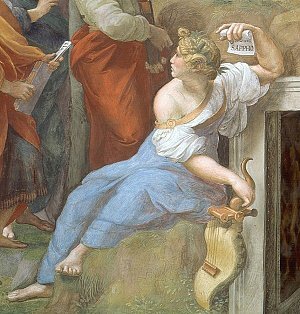
The divine group is surrounded by a large number of poets, both ancient and modern.
In the foreground on the left, as the caption reads, is Sappho, the only female poet in the scene.
Behind her are grouped the three great epic authors: Homer, raising his blind eyes to the heavens; Dante, with his characteristic profile; and Virgil, pointing to Calliope, the muse who is the source of his inspiration.
.
The composition is strongly influenced by the presence of a window overlooking the courtyard of the Belvedere.
Raphael uses the opening to his advantage, placing two groups of figures on either side that seem to be leaning out beyond the surface of the painting.
In particular, the two figures in the foreground on the right, pointing beyond the painting, seem to be trying to establish a link with reality.
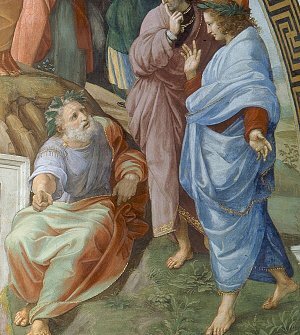
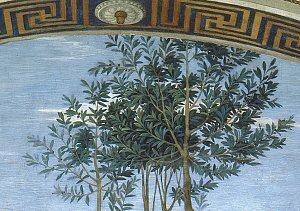
The trees on Mount Parnassus are laurels, whose branches were woven into the poets' crowns.
The foliage is partly cut off by the arch that frames the scene, creating the illusion that it extends beyond it, into real space.
Disputation over the Most Holy Sacrament
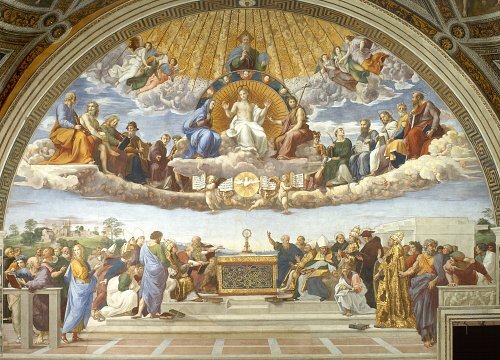
Facing the School of Athens and corresponding to Theology is the fresco known as the Disputation of the Most Holy Sacrament, although a more accurate description would be Triumph of Religion.
Flanking the Blessed Trinity - God the Father, Christ between the Virgin and St John the Baptist, and the Holy Spirit in the centre - would be the upper side of the Triumphal Church.
Patriarchs and prophets from the Old Testament, among apostles and martyrs, are seated in a semicircle on clouds, from left to right as represented: St. Peter, Adam, St. John the Evangelist, David, St. Lawrence, Judas Macchabeus, St. Stephen, Moses, St. James the Apostle, Abraham and St. Paul.
Below, next to the altar dominated by. St Gregory the Great (as Julius II), St Jerome, St Ambrose and St Augustine sit on marble thrones beside the altar. Some people also look like famous real-life figures; for example, the Pope on the far right looks very much like Sixtus IV (who was Julius II's uncle).
Behind them is Dante Alighieri, and the monk on the far left is reminiscent of Fra Angelico.
Cardinal and Theological Virtues and the Law

Facing the Parnassus, parallel to Justice, are the Cardinal Virtues - Fortitude, Prudence and Temperance, with Faith, Hope and Charity above in the lunette.
At the bottom of the window are images of the presentation of the Pandects to Justinian on one side and the presentation of the Decretals to Pope Gregory IX on the other. Julius II, who commissioned the work and was Pope from 1503 to 1513, is depicted here. With him are Cardinals Giovanni de' Medici and Alessandro Farnese - who later became Popes Leo X from 1513 to 1521 and Paul III from 1534 to 1549.
The painting depicting the handing over of the Pandects to the Emperor Justinian is attributed to Lorenzo Lotto.
Ceiling
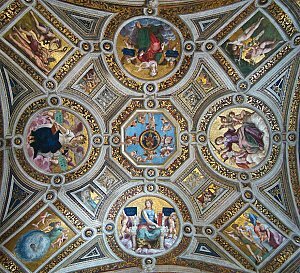
The four-part ceiling contains female allegories of the four faculties of the mind: philosophy, theology, poetry and justice.
They are detailed and elaborated in the large compositions on the surrounding walls.
Philosophy refers to Raphael's world-famous School of Athens, theology to the dispute over the Blessed Sacrament, poetry to Parnassus, and justice to the cardinal and theological virtues as well as the law.
